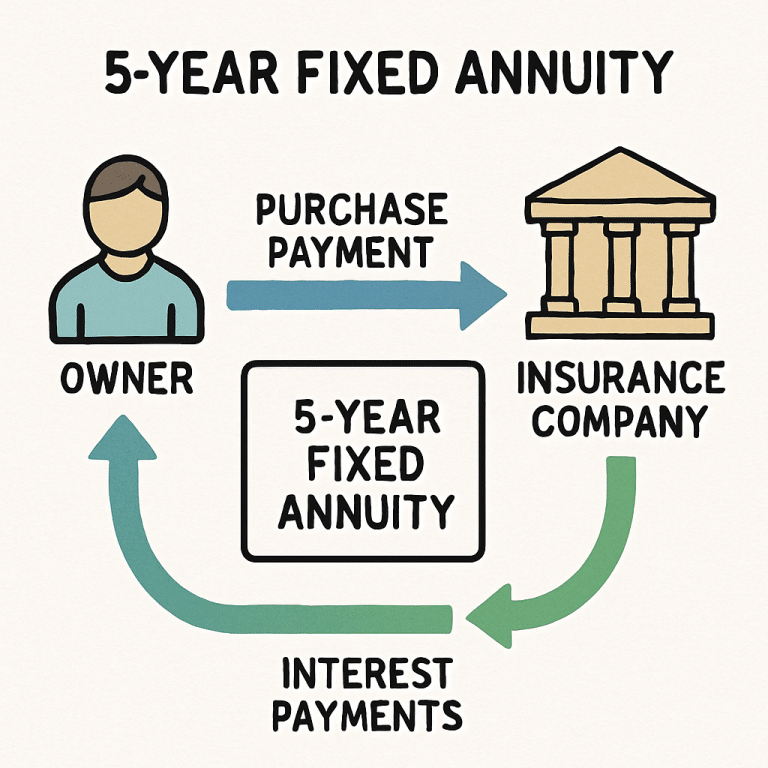Jason has distributed more than $1.5 billion in annuities over his 20 year career. His mission is to democratize access to annuities for all Americans and provide a safe and simple way to purchase an annuity.
Fixed annuities pay a guaranteed interest rate for a set period of time. They are often referred to as "CD Type" annuities due to their similarity to a certificate of deposit.
*Illustrative snapshot. Click below for live updates & full comparison including carrier strength, liquidity, and renewal options.
Rates subject to change without notice. Availability & features vary by state and insurer. Guarantees are backed by the claims‑paying ability of the issuing insurance company. Not a bank product. Not FDIC insured. State guaranty association limits apply (vary by state).
As of December 10, 2025, the best 5 year fixed annuity rate stands at 6.30%. For a detailed review, a downloadable brochure, and product calculators, click the product name in the table below.
| Carrier / Product Name |
AM Best Rating |
Rate (Fixed) |
Free Withdrawal Yr 1 | Yr 2+ |
Action |
|---|---|---|---|---|
| KIGHTHEAD LIFE - Staysail 5 (simple interest) | A- | 6.30% | None | Apply |
| AMERICAN GULF - Anchor MYGA 5 | B++ | 6.30% | None | Apply |
| WICHITA NATIONAL LIFE - Security 5 MVA | B+ | 6.25% | None | Apply |
| AMERICAN GULF - Anchor MYGA 5 (with 10% free w/d) | B++ | 6.15% | 10% | 10% | Apply |
| REVOL-ONE - DirectGrowth 5 | B++ | 5.85% | None | Apply |
| REVOL-ONE - DirectGrowth 5 (with interest withdrawals) | B++ | 5.75% | Interest | Apply |
| KIGHTHEAD LIFE - Staysail 5 (simple interest) | A- | 5.85% | 10% | 10% | Apply |
Currently, a 5 year annuity from a life insurance company with an AM Best rating of B+ is 6.30%. This is 1.70% more than the best rate from an A++ rated company, highlighting the importance of comparing the best 5 year fixed annuity rates.

Financial ratings: The highest rates often come from insurers with lower financial ratings, which can indicate higher risk.
Rates and features vary by state: Not all rates are available in all states, and features, benefits, and liquidity options can vary widely.
Liquidity: Some fixed annuities offer 10% free withdrawals or interest-only withdrawals annually, while others are illiquid and penalize early withdrawals.
Shop around: Compare multiple insurers and consider consulting a licensed annuity professional to align products with your goals and risk tolerance.
Simple vs. compound interest: Many fixed annuities use compounding, but not all. If you aren’t taking withdrawals, compounding can significantly boost growth over time.
A 5-year fixed annuity is a financial contract between you and an insurance company that guarantees a fixed interest rate on your investment for exactly five years. Think of it as a longer-term CD with insurance company backing—your principal is protected, your rate is locked in, and your interest grows tax-deferred.
The process is straightforward:

 Important Considerations
Important ConsiderationsA five year annuity may be right for you if:


To understand where annuity rates are going, you have to look at where the Federal Reserve has been. There is a distinct relationship between the Federal Funds Rate (the red dashed line) and Fixed Annuity/MYGA rates (the blue solid line), as shown in the chart above.
When the Federal Reserve raises interest rates, new bonds issued pay higher yields. Insurance companies invest in high-quality corporate and government bonds. So when these rates are higher they pass on some of those higher yields to you with higher annuity rates.
However, this doesn’t happen overnight. As the chart illustrates, there is a “Lagging Correlation.”
From the lows of 2021, where rates hovered near 2%, we witnessed a historic climb. As the Fed battled inflation with aggressive hikes, annuity buyers entered a “Golden Age” of safe accumulation. By late 2024, MYGA rates had more than tripled.
However, the tide is beginning to turn. As we move through 2025, the chart shows the Federal Funds Rate (red line) beginning to drop. While annuity rates (blue line) held strong at their peak for a while, we are now seeing them start to inch downward. The “lag” that worked in your favor on the way up is now signaling that the peak may be behind us.
Looking ahead to 2026, most reputable financial institutions and the Federal Reserve’s own projections (the “dot plot”) suggest a continued cooling of rates.
What does this mean for you? If the Fed continues to cut rates into 2026, annuity rates will almost certainly follow suit.
The Risk of Waiting: If the trend keeps going, waiting until 2026 could mean getting a rate that is 1% to 1.5% lower than the rates today.
The Bottom Line: If you see a rate that meets your accumulation goals today, it is generally wiser to lock it in rather than gambling on a market that is trending downward.

Bonds, CDs, and fixed annuities are all conservative investments commonly used in the fixed income portion of a portfolio. It just happens that right now fixed annuity rates are higher than CD rates and most bond yields.
A fixed annuity is more of a long-term commitment than bonds or CD and they grow tax-deferred like other retirement accounts. If you would like you can quickly and easily compare the after tax returns for each using our CD vs Fixed Annuity Calculator.
Multi-Year Guaranteed Annuity (MYGA): A Multi-Year Guaranteed Annuity (MYGA) offers a fixed interest rate. This rate is guaranteed for the entire length of your contract.
Variable Annuities: Variable annuities provide an opportunity to invest your contributions in various sub-accounts tied to the performance of the stock market. This flexibility allows for potentially higher returns, but it also comes with increased risk.
Single Premium Immediate Annuity: Provides regular income payments soon after the investor purchases the contract. This usually happens within 30 days and always within 13 months.
Traditional Fixed Annuity Rates: Traditional fixed annuity rates do not promise a fixed interest rate for the whole contract. The first year’s rate is specified, and a new rate is set on each anniversary.
Fixed Index Annuity Rates: Fixed index annuity rates combine fixe annuities and variable annuities. They provide the chance for extra earnings based on how a stock market index performs with downside protection.
Complete this interactive checklist to assess your readiness
Buying an annuity is a smart way to secure guaranteed income, but it requires careful planning and consideration. By following this step-by-step guide and using the checklist, you can confidently choose the right annuity for your retirement needs.
Remember, an annuity is a long-term commitment, so take your time to understand the product, shop around, and consult with professionals to ensure your decision is the right one for your financial future.
At maturity, you typically have several options: renew into a new term (often with a renewal rate), transfer to another annuity, take a full or partial withdrawal, or annuitize for income. Most carriers provide a 30-day window to choose before defaulting to a renewal or fixed account option per the contract.
Yes, but early withdrawals during the surrender period may incur surrender charges and market value adjustments (if applicable). Many contracts allow up to 10% penalty-free withdrawals annually, and most offer waivers for qualifying events like terminal illness or nursing care—subject to contract terms.
Earnings grow tax-deferred. Withdrawals are generally taxed as ordinary income, and if you’re under 59½, a 10% IRS penalty may apply to taxable amounts. In non-qualified contracts, taxes apply only to the earnings portion; qualified annuities are taxed based on plan rules. Consult a tax professional for your situation.
State guaranty associations provide protection up to statutory limits that vary by state and are not a substitute for an insurer’s financial strength. Coverage is not FDIC insurance. Always review carrier ratings and diversification. For specifics, contact your state guaranty association.
5-year fixed annuity rates generally move with intermediate-term bond yields and insurer portfolio returns. They may out-yield CDs of similar terms, with tax-deferred growth as an added benefit. Always compare net of surrender terms, liquidity features, and your time horizon.
Jason has distributed more than $1.5 billion in annuities over his 20 year career. His mission is to democratize access to annuities for all Americans and provide a safe and simple way to purchase an annuity.
We regularly update this page and cite primary sources, carrier filings, and regulator guidance:
Understanding these key terms helps you make informed decisions and avoid surprises.
Guaranteed Interest Rate
This is the fixed rate the insurance company promises to pay for your entire five-year term. It’s stated in your contract and cannot be changed.
Surrender Period and Charges
The surrender period is the time period surrender charges are applied to early withdrawals. The surrender period is equal to the length of the annuity contract, so five years for a 5-year annuity.
Free Withdrawal Provisions
These are the amounts you can withdraw each year without triggering surrender charges. The most common provisions are 10% of your account value annually, or free withdrawals of your interest earned.
Renewal Rates
When your five-year term ends, if you don’t take action, most annuities automatically renew at the company’s current rates. Typically, you have a 30-day window to make a decision, so plan ahead.
Annuitization Options
Annuitization is the process of converting a lump sum into a stream of guaranteed income payments. It is a requirement that all fixed annuity contracts offer an annuitization option at maturity.
Death Benefit
If you die during the five-year term, your beneficiaries receive the annuity’s current value (your original deposit plus accumulated interest). Most contracts waive surrender charges upon death, but some require the beneficiary to hold the annuity to the end of the surrender period.
Complete this interactive checklist to assess your readiness
Buying an annuity is a smart way to secure guaranteed income, but it requires careful planning and consideration. By following this step-by-step guide and using the checklist, you can confidently choose the right annuity for your retirement needs.
Remember, an annuity is a long-term commitment, so take your time to understand the product, shop around, and consult with professionals to ensure your decision is the right one for your financial future.






Important Disclosure:
The rates displayed in this comparison table are for informational purposes only and are subject to change without notice. Actual rates may vary based on individual circumstances, including age, state of residence, premium amount, and product availability. Rates are current as of [DATE] and should be verified at the time of application.
This comparison is not intended as a recommendation or endorsement of any specific insurance company or product. My Annuity Store, Inc. is an independent insurance agency and is not affiliated with or acting as a fiduciary for any insurance carrier listed. We receive compensation from insurance companies for the sale of annuity products in the form of commissions, which may vary by carrier and product.
Annuities are long-term financial products designed for retirement purposes. Early withdrawals may be subject to surrender charges, tax penalties, and other fees. Before purchasing an annuity, carefully review the product prospectus or disclosure documents and consult with a qualified financial or tax professional to determine if an annuity is appropriate for your specific situation.
Past performance and current rates are not guarantees of future results. All guarantees are backed by the claims-paying ability of the issuing insurance company.
For questions or to discuss which annuity option may be right for you, contact My Annuity Store at 855-583-1104 or info@myannuitystore.com.
Tip: Check spam/promotions if you don’t see our email on time.
Need help sooner or have a quick question?
What happens next
Tip: Check your spam or promotions folder if you don’t see our email within the time window.